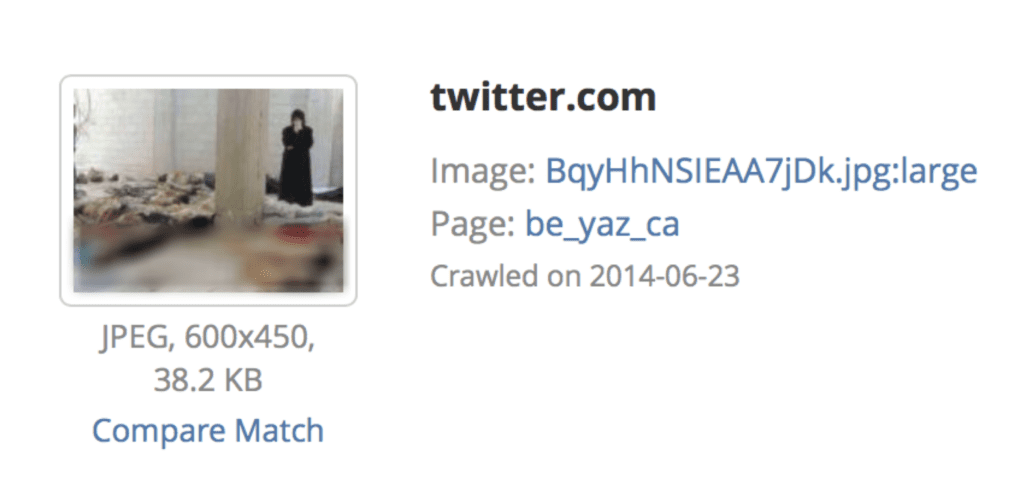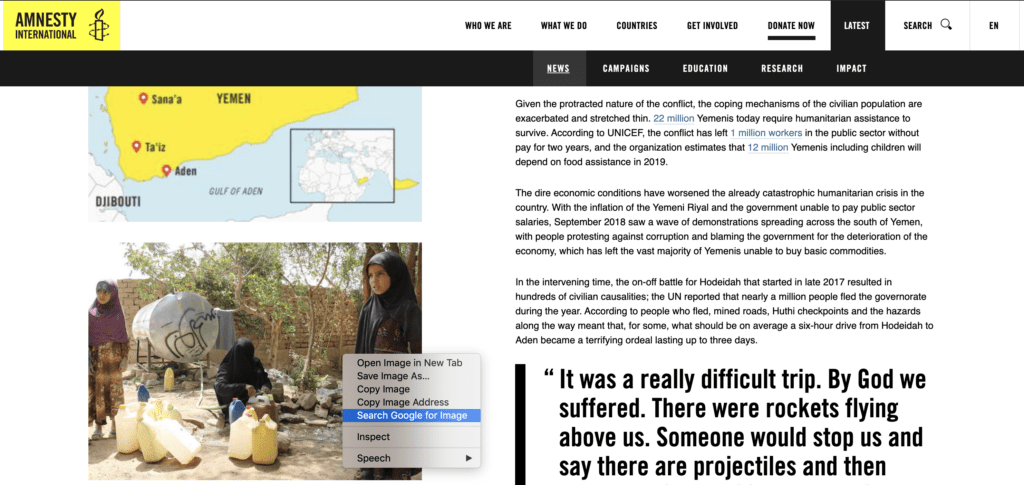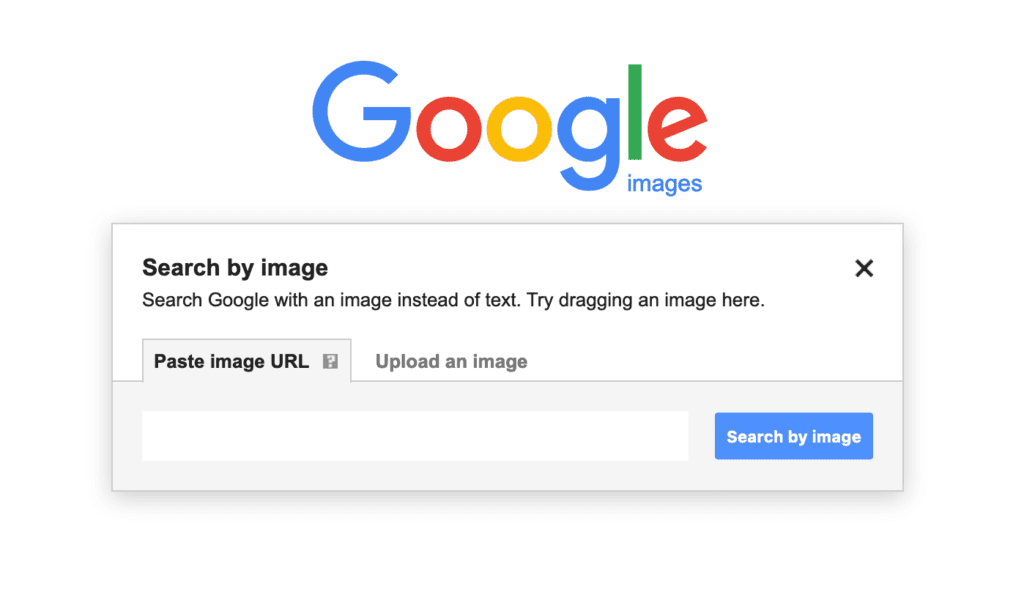Tools needed: InVid-WeVerify plugin installed in Chrome or Firefox, Screenshot tool for video searches
Skill Level: Basic
WHY USE REVERSE IMAGE SEARCH?
One of the introductory tools that we share in our trainings is a “reverse image search.” It is the first step we take to verify a piece of visual content in many of our investigations. A reverse image search allows an investigator to search image databases on the internet for previous versions of the same picture. This is crucial for determining if an old image is being “recycled” as new. Especially during emerging crises, old pictures are often posted online — often purporting to portray something other than they actually do portray — and go viral due to uncritical re-sharing through social networks (this happens regularly both during complex emergencies and natural disasters). Further, a reverse image search can help an investigator track down the original uploader of a particular piece of media.
Tip: A reverse image search can also be highly useful to track down previous versions of YouTube videos. In this case, perform a reverse image search with the thumbnails that are created by YouTube when uploading a video (all thumbnails automatically generated by YouTube can be extracted through the InVid Plugin or Amnesty’s Youtube Data Viewer).
Reverse image searches can also be used to conduct a more in-depth analysis of an image or video, allowing the researcher to isolate and analyze distinct features such as buildings, vehicles, or other signs and symbols that may help to establish the time and place of the event. Researchers have also been successful in using reverse image search for facial recognition to identify the actors involved.
In the example below, this image of a woman mourning dead children was tweeted and shared widely in relation to emerging reports of Syrian government forces advancing into eastern Aleppo, beginning on the evening of 12 December 2016.

However, a reverse image search shows that this image appeared on the Internet as early as 2014, quickly revealing that it was not captured on 12 December 2016 or anytime thereafter.

HOW TO CONDUCT A REVERSE IMAGE SEARCH?
The simplest way to run a reverse image search is by using a built-in feature on the Google Chrome browser. Simply right-click on any image and select “Search Google for image”. Chrome will then open up a separate browser tab and search images.google.com for the image selected.

You can also conduct a reverse image search on images.google.com by entering the image URL or by uploading an image file from your own computer.

While not as efficient as the two-click method described above, this can be useful for analyzing image files sent directly to a researcher, or for running a reverse image search on a screenshot of a particular frame of a video.
MORE THAN JUST GOOGLE
While Google is the go-to search engine for many people, when it comes to reverse image search open source investigators should not limit themselves to this platform alone. There are many other tools and search engines that are capable of conducting reverse image searches and are often much better at it. Depending on the situation, other tools might create a more thorough search and and comprehensive set of results. Some of the main alternatives used today are Yandex, Bing, TinEye, and Baidu. Researchers should be aware of these other options and the benefits of each:
Yandex
According to a recent comparative study carried out by Bellingcat’s Aric Toler on the reverse image search capabilities of major search engines, the Russian site Yandex was the clear frontrunner. In this study, Yandex was the best at identifying faces, landscapes, and objects in images, outperforming both Google and Bing. The site also has excellent facial recognition algorithms which have been shown to identify exact facial matches from photographs. While Yandex is more effective in identifying content originating from Russia, Ukraine or eastern Europe, it will often return useful results with images taken outside of this region and is always worth checking when running a reverse image search.
Bing
While not widely used for text-based searches, Microsoft’s search engine Bing has comparable reverse image search capabilities to that of Google as well as an additional unique feature. When running a search on Bing’s “Visual Search”, the site allows an investigator to crop the image to focus on a specific element of it, whether it be a particular building, street sign, or other notable feature. The search results will then focus on the cropped image and exclude extraneous elements which may otherwise interfere with the results.

TinEye
Of all the tools mentioned in this guide, TinEye is the only site exclusively dedicated to reverse image searches. While the service is designed to identify only exact duplicates of the original image and therefore frequently returns no results, it can still be useful as it uniquely sorts any results by the earliest to the most recently indexed image in its database. This can be particularly useful for identifying when an older image has been falsely used in relation to a more recent event, or potentially for identifying the original source of an image.
Baidu
Similar to Yandex, which is especially good for researchers looking into content originating from Russia and eastern Europe, the Chinese search engine Baidu may provide a more effective reverse image search tool for images that are likely to appear in Chinese news outlets or are of Chinese landmarks/locations.
SEARCHING MULTIPLE SITES WITH INVID
While each of these sites presents similar options to search for an image either by uploading the image file directly or pasting a URL into the search bar, searching for the same image on multiple sites in this way would be time consuming and tedious. Fortunately, there is an all-purpose verification browser extension, InVid, which makes it possible to conduct two-click reverse image searches across all of these platforms. (For more on InVid, see our tutorial here)
With the InVid browser extension installed, the dropdown menu generated by right-clicking on an image will give the option to search on a number of sites supported by InVid as seen below:

CONCLUSION
Reverse image search is a key step in any visual investigation. It is one of the quickest ways to verify and analyze an image and is an essential tool that all open source researchers should know how to use. Beyond locating previous versions of the same image, it can also be an effective tool for identifying landscapes, buildings, or even individual people shown in a particular piece of media. However, while there are many sites that researchers can use to conduct reverse image searches, they are not all equal. Each will yield different results and may excel with certain types of content or in identifying particular features of an image. To be effective, researchers should understand these differences, know when to use each site, and always search on multiple platforms.


